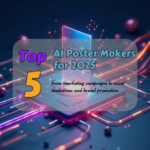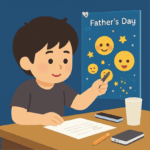Will Graphic Designers Be Replaced By AI Graphic Design Generators? (2025)
Introduction: The AI Design Revolution
In today’s fast-paced digital landscape, AI graphic design generators are rapidly transforming the creative industry. With tools like MolyPix.AI gaining popularity, many are questioning: are human designers becoming obsolete? According to recent data from Adobe, 83% of creative professionals now use some form of AI in their workflow, a 230% increase from just two years ago. This surge in AI adoption has sparked an important conversation about the future of design careers and processes.
As businesses seek faster turnaround times and cost-effective solutions, AI graphic design generators offer compelling advantages. These tools can create logos, social media graphics, and marketing materials in minutes rather than hours or days. But does efficiency come at the cost of creativity, emotional intelligence, and strategic thinking that human designers bring to the table?
While AI graphic design generators like MolyPix.AI are undeniably reshaping workflows by automating repetitive tasks and enhancing efficiency, they serve more as powerful assistants than replacements for the unique creativity and problem-solving capabilities that human designers possess.
What Are AI Graphic Design Generators?
Understanding the Technology Behind AI Design
AI graphic design generators utilize advanced algorithms and machine learning technologies to automatically create visual content based on input parameters. Unlike traditional design software that requires manual manipulation, these AI systems can independently generate designs after being trained on vast datasets of existing visual content.
Modern AI design tools employ several key technologies:
- Machine Learning: Systems learn patterns from millions of design examples
- Natural Language Processing: Converting text instructions into visual elements
- Computer Vision: Analyzing and understanding visual content
- Generative Adversarial Networks (GANs): Creating new, original images based on training data
Current Capabilities of AI Design Tools
Today’s AI graphic design generators can perform numerous tasks that previously required human designers:
- Automatically generate layout compositions for various formats
- Create color palettes and typography pairings
- Resize designs for different platforms while maintaining visual integrity
- Produce multiple design variations from a single concept
- Generate social media graphics, logos, and marketing materials
- Create image manipulations and photo editing effects
MolyPix.AI, as one example in this growing field, helps both designers and non-designers create professional-quality visuals with significantly reduced time investment. These tools democratize design capabilities by making professional-looking assets accessible to those without formal design training.
The Strengths of AI Graphic Design Generators
Speed and Efficiency: Design in Minutes, Not Hours
One of the most compelling advantages of AI graphic design generators is their ability to produce work at unprecedented speeds. What might take a human designer several hours can be accomplished in minutes with AI assistance.
For example, creating social media content for an entire month’s marketing campaign—including properly sized images for multiple platforms with consistent branding—can be generated in a single session with an AI tool. This efficiency allows businesses to:
- Respond quickly to trending topics
- Test multiple design directions simultaneously
- Meet tight deadlines without requiring overtime work
- Scale content production without proportionally increasing labor costs
Accessibility: Democratizing Design Skills
AI graphic design generators have significantly lowered barriers to entry in visual communication. Small businesses and entrepreneurs who previously couldn’t afford professional design services can now create visually appealing materials independently.
This democratization extends to:
- Startups with limited marketing budgets
- Content creators needing consistent visual assets
- Non-profit organizations with restricted resources
- Individuals without formal design training but needing professional-looking materials
Cost Effectiveness: Budget-Friendly Design Solutions
The financial benefits of AI graphic design generators are substantial:
- Reduced need for specialized design software subscriptions
- Lower personnel costs for basic design tasks
- Decreased reliance on freelancers for simple projects
- Minimized revision cycles through rapid iteration
Consistency in Brand Identity
Maintaining visual consistency across all touchpoints is essential for brand recognition. AI graphic design generators excel at enforcing brand guidelines:
- Perfectly consistent color application
- Standardized typography usage
- Uniform spacing and layout principles
- Reliable application of logo usage rules
This consistency becomes increasingly valuable as marketing channels multiply and content needs expand.
The Unique Strengths of Human Designers
Creativity and Innovation: The Human Advantage
While AI graphic design generators can create visually pleasing compositions, they fundamentally operate by recombining and iterating on existing patterns they’ve been trained on. True innovation—creating something genuinely novel—remains a distinctly human capability. Designers bring several irreplaceable creative qualities:
- Original conceptual thinking that transcends existing patterns
- Intentional rule-breaking that leads to groundbreaking aesthetics
- Cultural insight that informs meaningful visual choices
- The ability to identify unexplored visual territory
Strategic Problem-Solving in Design
Design is fundamentally about solving problems, not just making things look attractive. Human designers approach projects with strategic thinking that AI currently cannot replicate:
- Understanding unstated client needs beyond the brief
- Identifying underlying business challenges that design can address
- Recognizing when convention should be followed versus challenged
- Adapting to unexpected feedback or changing project parameters
This problem-solving approach extends beyond aesthetics to the functional purpose of design—communicating specific messages to specific audiences with specific goals in mind.
Cultural and Emotional Intelligence
Perhaps the most significant advantage human designers maintain is their innate understanding of cultural nuance and emotional resonance:
- Recognizing culturally sensitive imagery or associations
- Understanding regional color symbolism and preferences
- Identifying potentially offensive visual elements
- Creating designs that evoke specific emotional responses
These capabilities stem from lived human experience that AI systems, regardless of their training data, cannot genuinely replicate.
Storytelling Through Visual Design
Human designers excel at visual storytelling—crafting narratives that connect with audiences on deeper levels:
- Creating visual journeys that unfold as viewers engage
- Establishing emotional connections through thoughtful composition
- Developing visual metaphors that communicate complex ideas
- Building cohesive brand narratives across multiple touchpoints
This narrative capability remains one of the most powerful tools in human-created design.
AI Graphic Design Generators: Enhancement or Replacement?
Tasks Where AI Design Tools Excel
AI graphic design generators have proven particularly effective in several areas:
- Template-Based Designs: Creating variations of established formats
- Rapid Prototyping: Generating multiple concept options quickly
- Design Scaling: Adapting existing designs to different dimensions
- Basic Photo Editing: Applying filters, adjustments, and effects
- Layout Generation: Creating balanced compositions from content elements
- Content Reformatting: Converting designs for different platforms
For these tasks, AI tools like MolyPix.AI offer significant time savings and consistent results.
Where Human Designers Maintain the Edge
Human designers continue to dominate in areas requiring:
- Strategic Brand Development: Creating comprehensive visual identities tied to business objectives
- Complex Problem-Solving: Designing solutions for multifaceted communication challenges
- Audience-Specific Messaging: Crafting visuals tailored to particular demographic insights
- Innovative Concept Development: Creating genuinely new design approaches
- Cross-Cultural Design: Creating globally appropriate visual communication
- Design Leadership: Guiding overall creative direction and maintaining vision
The Collaborative Future: AI + Human Designers
Rather than a zero-sum competition, the most productive relationship between AI graphic design generators and human designers is collaborative. Industry research indicates that designers who effectively incorporate AI tools report:
- Increased productivity on routine tasks
- More time for creative conceptualization
- Greater client satisfaction through faster iteration
- Enhanced ability to explore design variations
The most successful model emerging is one where designers use AI as an extension of their creative toolkit—delegating repetitive tasks while focusing their human talents on strategy, innovation, and client relationships.
Challenges and Limitations of AI Graphic Design Generators
The Context Gap: What AI Can’t Understand
Despite impressive capabilities, AI graphic design generators face significant limitations in contextual understanding:
- Cultural Relevance: AI may create designs that are technically proficient but culturally inappropriate
- Brand Evolution: Understanding when brand guidelines should evolve versus remain consistent
- Audience Perception: Anticipating how specific demographics will interpret visual elements
- Historical References: Recognizing when designs unintentionally echo problematic imagery
This context gap stems from AI’s fundamental nature as a pattern-recognition system rather than a truly understanding entity.
The Creativity Ceiling
Current AI graphic design generators face inherent creative limitations:
- Reliance on existing patterns rather than true innovation
- Difficulty creating designs that feel genuinely original rather than derivative
- Tendency to produce “average” designs that reflect training data medians
- Challenges with abstract concepts that can’t be directly represented
As designer Michael Bierut notes: “AI can show you what design typically looks like, but not what it could be.”
Ethical Considerations in AI Design
The rise of AI graphic design generators raises important ethical questions:
- Copyright Concerns: AI systems trained on copyrighted materials may reproduce elements of protected work
- Design Homogenization: Widespread AI use could lead to increasingly similar visual landscapes
- Attribution Questions: Unclear ownership of AI-generated designs
- Job Displacement: Potential economic impact on entry-level design positions
These ethical considerations require ongoing industry attention and potential regulatory frameworks.
Technical Limitations
Current AI design tools still face practical limitations:
- Difficulty with complex, multi-page documents requiring narrative flow
- Challenges with typography for specialized applications
- Limited understanding of production requirements for physical media
- Inconsistent handling of brand assets without explicit direction
These technical constraints continue to necessitate human oversight and intervention.
People Also Ask: Common Questions About AI Graphic Design Generators
How Much Do AI Graphic Design Generators Cost?
AI graphic design generators vary widely in pricing structure:
- Subscription-Based Models: Typically ranging from $15-$99/month for individual users
- Enterprise Solutions: Custom pricing for larger organizations, often $500-$5000/month
- Free Tiers: Many platforms offer limited functionality without cost
- Pay-Per-Generation: Some services charge based on usage rather than time
Most professional-grade tools operate on tiered subscription models with increasing capabilities at higher price points.
What Skills Do Designers Need in the Age of AI?
As AI graphic design generators become more prevalent, designers should focus on developing:
- Strategic thinking and business acumen
- Client communication and requirement analysis
- Conceptual creativity beyond execution
- AI prompt engineering and tool mastery
- Art direction and creative leadership
- Brand strategy and identity development
- Cultural awareness and inclusive design principles
These “uniquely human” skills will remain valuable regardless of AI advancement.
Are There Copyright Issues With AI-Generated Designs?
The copyright status of AI-generated designs remains legally complex:
- Most AI tools’ terms of service grant commercial usage rights to users
- Some jurisdictions are developing specific frameworks for AI-generated content
- Designs heavily based on protected works may still raise infringement concerns
- Best practice includes human review and modification of AI outputs
Organizations should consult legal experts when establishing policies around AI-generated design assets.
How Can Non-Designers Get the Most From AI Design Tools?
Non-designers can maximize AI graphic design generators by:
- Understanding basic design principles to evaluate outputs
- Creating clear brand guidelines for AI tools to follow
- Learning effective prompt engineering techniques
- Combining multiple AI-generated elements into cohesive designs
- Using AI tools for ideation before finalizing selections
- Seeking feedback from design professionals on important projects
With these approaches, non-designers can produce significantly improved visual content.
The Future Landscape: AI and Human Designers in Partnership
AI as a Creative Catalyst
Forward-thinking designers increasingly view AI graphic design generators as creativity amplifiers rather than threats:
- Using AI to quickly visualize concepts during ideation
- Generating unexpected variations that inspire new directions
- Accelerating the exploration phase of design projects
- Reducing time spent on technical execution
This perspective positions AI as a collaborative partner in the creative process—enhancing human capability rather than replacing it.
Emerging Design Specializations
The AI design revolution is creating new career opportunities:
- AI Design Specialists: Experts in maximizing AI tool capabilities
- Design Systems Architects: Creating frameworks for AI implementation
- Prompt Engineers: Crafting effective instructions for AI design systems
- AI Output Editors: Professionals who refine and customize AI-generated content
- Design Strategists: Focus on higher-level thinking while delegating execution
These roles represent an evolution of design careers rather than their elimination.
The Human-AI Design Workflow
Effective integration of AI graphic design generators typically follows a hybrid workflow:
- Human strategizes and establishes project parameters
- AI generates multiple design options based on direction
- Human evaluates, selects, and provides refinement guidance
- AI implements specific changes while maintaining design integrity
- Human finalizes, contextualizes, and presents the work
This collaborative approach leverages the strengths of both human creativity and AI efficiency.
Personalized AI Design Assistance
The next frontier in AI graphic design generators involves personalization:
- AI systems that learn individual designer preferences
- Tools that adapt to specific brand guidelines automatically
- Customized interfaces based on user workflow patterns
- Specialized capabilities for different design disciplines
These advancements will further enhance the collaborative potential between human designers and AI tools.
How MolyPix.AI Enhances Designer Workflows

Accelerating the Design Process
MolyPix.AI can significantly transform a designer’s workflow through automation of time-consuming tasks, allowing for greater focus on creative strategy. Professional designers can leverage this tool to:
- Generate Initial Concepts: Rapidly produce multiple design directions as starting points for further refinement
- Create Variations: Instantly develop alternative versions of a concept to present to clients
- Streamline Text-to-Design Conversion: Transform written concepts into visual designs with simple text prompts, eliminating the initial blank canvas challenge
- Create Platform-Specific Content: Quickly generate social media graphics, posters, logos, and marketing materials tailored to specific campaign needs
This acceleration doesn’t replace the designer’s role but instead eliminates much of the routine production work that can consume valuable creative time.
Enhancing Creative Exploration
MolyPix.AI can serve as a collaborative brainstorming partner for designers by:
- Generating unexpected design combinations that might not have been considered
- Providing instant visualization of concepts that would take hours to mock up manually
- Allowing rapid testing of different color schemes, typography options, and layout approaches
- Presenting alternative interpretations of design briefs that can spark new creative directions
In this capacity, the AI functions as a creativity multiplier rather than a replacement—expanding the designer’s ability to explore diverse solutions quickly.
Collaborative Workflow Integration
The most effective implementation of MolyPix.AI comes through thoughtful integration into existing design processes:
- Designers can establish creative direction and brand needs
- MolyPix.AI generates initial options following these guidelines
- Designers select promising directions and provide refinement guidance
- The AI implements technical adjustments while preserving creative intent
- Designers finalize the work, adding nuance and contextual sensitivity
This collaborative approach maintains the designer’s essential role as creative director while leveraging AI to handle execution aspects—creating a partnership that enhances rather than diminishes the human element in design.
Conclusion: The Complementary Future of Design
The question isn’t whether AI graphic design generators will replace human designers, but how these technologies will transform the practice of design itself. The evidence suggests that the most productive path forward is one of collaboration rather than competition.
AI excels at speed, consistency, and generating variations—allowing designers to focus on strategy, innovation, and human connection. This partnership approach offers the best of both worlds: the efficiency of artificial intelligence combined with the irreplaceable creativity, emotional intelligence, and strategic thinking of human designers.
As AI graphic design generators like MolyPix.AI continue to evolve, designers who embrace these tools as collaborators rather than threats will find themselves at the forefront of a new creative landscape—one with expanded possibilities rather than diminished opportunities.
The future of design isn’t human versus machine, but human enhanced by machine.
Your Next Steps in the AI Design Journey
Ready to explore how AI graphic design generators can enhance your creative workflow? Consider these action steps:
- Experiment with leading AI design tools to understand their capabilities and limitations firsthand
- Identify repetitive design tasks in your workflow that could benefit from automation
- Develop your prompt engineering skills to better direct AI tools toward desired outcomes
- Focus on strengthening your strategic design thinking to complement AI’s execution capabilities
- Join communities discussing the ethical implications of AI in creative fields
By thoughtfully integrating AI graphic design generators into your process while continuing to develop uniquely human creative skills, you’ll be well-positioned for success in the evolving design landscape.




